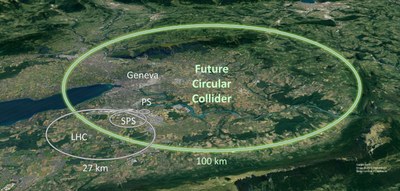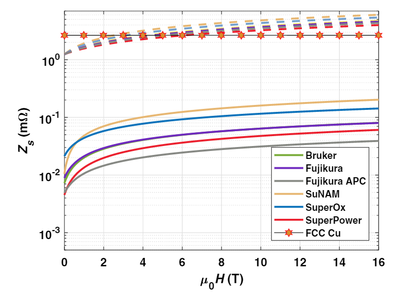
Figure: The scale of the FCC-hh as compared to the already existing Large Hadron Collider (LHC). Credit: CERN.
Cerdanyola del Vallès, Agust 13th 2020. The Future Circular Collider Study (FCC) is developing designs for a higher performance particle collider to extend the research currently being conducted at the Large Hadron Collider (LHC), once the latter reaches the end of its lifespan, after 2035.
The goal of the FCC is to greatly push the energy and intensity frontiers of particle colliders, with the aim of reaching collision energies of 100 TeV, in the search for new physics.
Highly conductive coatings to stabilize the proton beams at the FCC
Under the umbrella of CERN´s FCC study, more than 100 institutes, among them, the ALBA Synchrotron, assess the feasibility of building a next generation, high energy circular collider as the successor to the LHC. New energy frontiers have to be explored in order to disentangle tantalizing mysteries of the universe related to dark matter or supersymmetry.
However, the collision energies of the proposed particle accelerator, targeted to exceed the LHC by a factor of seven, come at a price. It is a huge challenge to guarantee a stable proton beam at such high energies due to excitation of wakefields as a consequence of a finite chamber resistivity. They result from mirror charges that are introduced into the surroundings of the protons. Highly conductive coatings within the beam screen chamber, which houses the beam, can offer a solution to the problem.
Understanding the behavior of magnetic vortices of superconducting materials at the FCC conditions
In this context, it was suggested to evaluate high temperature superconductors as a beam screen coating candidate. The integral property for a beam screen coating is a low surface impedance at the expected extreme FCC-hh conditions, i.e. at a temperature of 50 K, 1 GHz accelerator frequency and up to 16 T of magnetic field. The overall surface resistance at these conditions will be governed by the magnetic field term. For that purpose, it is mandatory to understand the behavior of magnetic vortices in high-temperature superconducting coated conductors at the mentioned conditions.
This manuscript, published in Scientific Reports, is a collaboration between researchers from the Superconducting Materials and Large Scale Nanostructures (SUMAN) group at the Institute of Materials Science of Barcelona (ICMAB, CSIC), the Accelerator Division of the ALBA Synchrotron, the Universitat Politècnica de Catalunya (UPC) and CERN. researchers disclose the surface resistance of seven commercially, in large scales available, REBa2Cu3O7-x (RE = Rare Earth) coated conductors at 8 GHz, 20-70 K and up to 9 T measured by a Hakki-Coleman dielectric resonator, which has been specifically designed, constructed and tested by the scientists at ALBA in close collaboration with the UPC. Researchers show how different microstructures of REBa2Cu3O7-x coated conductors, which depend on tunable growth conditions and nano additions used by manufacturer, result in quite a wide variety of surface impedances and vortex parameters.
By modelling the field behavior of the surface resistance, they contribute to the understanding of vortex pinning properties at high frequencies in thick REBa2Cu3O7-x films. They give frequency limits for the low dissipative pinning regime and highlight explicit links between microstructure, superconducting properties and vortex parameters. Finally, estimations of the surface impedance for each coated conductor are made based on extracted vortex parameters for expected FCC-hh conditions.
These calculations suggest surface resistances up to 70 times smaller than displayed by copper, which is the material used as a beam screen coating in the LHC. Expected margins in surface resistance of REBa2Cu3O7-x coated conductors can enable more efficient and sustainable FCC-hh options and eventually tip the scales in the realization decisions for CERN’s future infrastructure.

Figure: To 50 K and 1 GHz extrapolated surface impedance for thick Cu sputtered on stainless steel, denoted here as FCC Cu, and several CCs as a function of magnetic field. The stars represent both the surface resistance and surface reactance values of FCC Cu. The solid lines are surface resistances, the dashed lines surface reactances of CCs. The providers of the CCs are color-coded.
Implications for microwave applications and materials science
This study also carries interesting implications for the field of microwave applications and materials science. On the one hand, the generated surface resistance data demonstrates the strong high frequency in-field performance of commercially available coated conductor technologies and thus underlines the maturity to be employed in microwave applications where large magnetic fields are imperative (like in the detection of axions in dark matter search ).
On the other hand, the demonstrated correlation between microstructure and vortex parameters can pave a route for production optimization of REBa2Cu3O7-x coated conductors in search of a sweet spot between cost efficiency and necessary microwave performance to meet the demands of specific applications.
Reference: High frequency response of thick REBCO coated conductors in the framework of the FCC study. Artur Romanov, Patrick Krkotić, Guilherme Telles, Joan O’Callaghan, Montse Pont, Francis Perez, Xavier Granados, Sergio Calatroni, Teresa Puig & Joffre Gutierrez. Scientific Reports 10, 12325, 2020. DOI: 10.1038/s41598-020-69004-z
Link to the original news: https://icmab.es/how-do-superconducting-coated-conductors-respond-to-the-extreme-temperature-frequency-and-magnetic-field-conditions-of-the-cern-future-circular-collider




